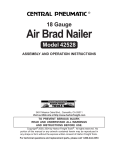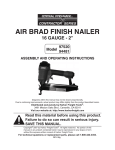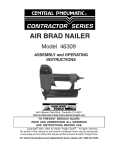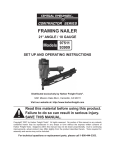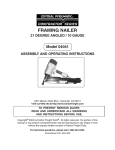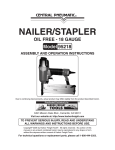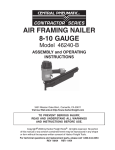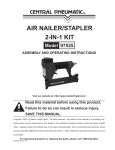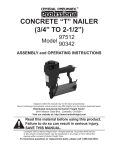Download Central Pneumatic 39092 Operating instructions
Transcript
® AIR BRAD NAILER 1-1/4” TO 2-1/2” Model 39092 ASSEMBLY AND OPERATING INSTRUCTIONS ® 3491 Mission Oaks Blvd., Camarillo, CA 93011 Visit our Web site at: http://www.harborfreight.com TO PREVENT SERIOUS INJURY, READ AND UNDERSTAND ALL WARNINGS AND INSTRUCTIONS BEFORE USE. © Copyright 2005 by Harbor Freight Tools®. All rights reserved. No portion of this manual or any artwork contained herein may be reproduced in any shape or form without the express written consent of Harbor Freight Tools. For technical questions or replacement parts, please call 1-800-444-3353. REV 06/05 Specifications Item Operating Air Pressure Air Consumption Magazine Capacity Brad Length Capacity / Gauge Size Air Inlet Trigger Mechanism Type Overall Dimensions Tool Weight Description 70-125 PSI * 3 CFM (Non-continuous) 100 Brads 1-1/4” to 2-1/2” / 16 Gauge 1/4”-18 NPT Contact Safety Trip Mechanism 12-1/2” L x 2-5/8” W x 10-1/4” H 5-5/8 Pounds * The air pressure setting must not exceed job site regulations/restrictions. The air pressure setting must not exceed 90 PSI when being used with work pieces that have a thickness of less than 1-3/4”. Save This Manual You will need this manual for the safety warnings and precautions, assembly, operating, inspection, maintenance and cleaning procedures, parts list and assembly diagram. Keep your invoice with this manual. Write the invoice number on the inside of the front cover. Keep this manual and invoice in a safe and dry place for future reference. Safety Warnings and Precautions WARNING: When using tool, basic safety precautions should always be followed to reduce the risk of personal injury and damage to equipment. Read all instructions before using this tool! 1. Keep work area clean. Cluttered areas invite injuries. 2. Observe work area conditions. Do not use machines or power tools in damp or wet locations. Do not expose to rain. Keep work area well lit. Do not use electrically powered tools in the presence of flammable gases or liquids. 3. Keep children away. Children must never be allowed in the work area. Do not let them handle machines, tools, extension cords, or air hoses. 4. Store idle equipment. When not in use, tools must be stored in a dry location to inhibit rust. Always lock up tools and keep out of reach of children. 5. Use the right tool for the job. Do not attempt to force a small tool or attachment to do the work of a larger industrial tool. There are certain applications for which this tool was designed. It will do the job better and more safely at the rate for which it was intended. Do not modify this tool and do not use this tool for a purpose for which it was not intended. REV 11/06 SKU 39092 For technical questions, please call 1-800-444-3353. Page 2 6. Dress properly. Do not wear loose clothing or jewelry as they can be caught in moving parts. Protective, electrically non-conductive clothes and non-skid foot wear are recommended when working. Wear restrictive hair covering to contain long hair. 7. Do not overreach. Keep proper footing and balance at all times. Do not reach over or across running machines or air hoses. 8. Use eye and ear protection. Always wear ANSI approved impact safety goggles and appropriate hearing protection. Wear a full face shield if you are producing metal filings or wood chips. Wear an ANSI approved dust mask or respirator when working around metal, wood, and chemical dusts and mists. Other people in the work area must also wear ANSI approved impact safety goggles. 9. Maintain tools with care. Keep tools clean for better and safer performance. Follow instructions for lubricating and changing accessories. Inspect tool cords and air hoses periodically and, if damaged, have them repaired by an authorized technician. The handle must be kept clean, dry, and free from oil and grease at all times. Do not operate a tool if any portion of the tool’s operating controls are inoperable, disconnected, altered or not working properly. 10. Disconnect Air Hose and release any built-up air pressure. Never perform service on the nailer, clear jams, or disassemble with the air hose attached. Always release any built-up air even after disconnecting hose. Disconnect the Nailer when not in use. 11. Remove adjusting keys and wrenches. Check that keys and adjusting wrenches are removed from the tool or machine work surface before attaching to an air source. 12. Avoid unintentional starting. Be sure the trigger is in the Off position when not in use and before plugging in. Do not carry any tool with your finger on the trigger, whether it is attached to an air source or not. Do not point the tool towards yourself or anyone whether it contains fasteners or not. 13. Stay alert. Watch what you are doing, use common sense. Do not operate any tool when you are tired. 14. Check for damaged parts. Before using any tool, any part that appears damaged should be carefully checked to determine that it will operate properly and perform its intended function. Check for alignment and binding of moving parts; any broken parts or mounting fixtures; and any other condition that may affect proper operation. Any part that is damaged should be properly repaired or replaced by a qualified technician. Do not use the tool if the trigger does not oper- SKU 39092 For technical questions, please call 1-800-444-3353. Page 3 ate properly. 15. Guard against electric shock. Prevent body contact with grounded surfaces such as pipes, radiators, ranges, and refrigerator enclosures. 16. Replacement parts and accessories. This product is to be repaired and serviced only by a qualified technician. When this product is serviced, only identical replacement parts should be used. Use of any other parts will void the warranty. Only use accessories intended for use with this tool. Approved accessories are available from Harbor Freight Tools. 17. Do not operate tool if under the influence of alcohol or drugs. Read warning labels if taking prescription medicine to determine if your judgement or reflexes are impaired while taking drugs. If there is any doubt, do not operate the tool. 18. Use proper size and type extension cord. If an extension cord is required, it must be of the proper size and type to supply the correct current to the compressor without heating up. Otherwise, the extension cord could melt and catch fire, or cause electrical damage to the tool. Check your air compressor’s manual for the appropriate size cord. It is also possible that the use of an extension cord may cause your circuit breaker to trip or your panel fuse to break. If this happens, either use the compressor without an extension cord or find a larger amperage circuit to use. 19. Maintenance. The maintenance outlined in the maintenance section should be performed regularly. For your safety, this product should be serviced or repaired regularly only by a qualified technician. 20. Compressed air only. Never use combustible gas as a power source. 21. Do not load brads with the trigger or safety depressed. Unintentional firing may occur. Do not load nails when the air hose is connected to the tool. Always assume the tool contains fasteners. 22. Disconnect air supply before loading the Nailer. Before reloading (or making any adjustments to) the Nailer, make sure the compressed air is disconnected. 23. Fire fasteners into an appropriate work surface only. Do not attempt to fire fasteners into surfaces too hard to penetrate. Do not drive fasteners on top of other fasteners, or at too steep an angle. Fasteners can ricochet causing personal injury. Never fire the Nailer into the air, or point it toward yourself or another person. Always wear ANSI approved safety goggles during use, maintenance, and reloading. SKU 39092 For technical questions, please call 1-800-444-3353. Page 4 24. Do not fire fasteners too close to the edge of a workpiece. They may split the workpiece and fly free, causing personal injury. 25. Take caution, as some woods contain preservatives such as copper chromium arsenate (CCA) which can be toxic. When stapling or nailing these materials extra care should be taken to avoid inhalation and minimize skin contact. WARNING: Some dust created by power sanding, sawing, grinding, drilling, and other construction activities contain chemicals known (to the State of California) to cause cancer, birth defects, or other reproductive harm. Some examples of these chemicals are: * Lead from lead-based paints * Crystalline silica from bricks and cement and other masonry products * Arsenic and chromium from chemically treated lumber. (California Health & Safety Code § 25249.5, et seq.) 26. Stay within air pressure capacity. Never operate the Nailer above 125 PSI. 27. Hold tool away from head and body. During operation the Nailer may kick back causing injury. 28. Transport Nailer safely. Always disconnect air supply when moving the tool in the workplace. Carry the tool by the handle to avoid contact with the trigger. 29. Avoid working alone. If an accident happens, an assistant can bring help. Note: Performance of the compressor (if powered by line voltage) may vary depending on variations in local line voltage. Extension cord usage may also affect the tool performance. Warning: The warnings, cautions, and instructions discussed in this instruction manual cannot cover all possible conditions and situations that may occur. It must be understood by the operator that common sense and caution are factors which cannot be built into this product, but must be supplied by the operator. Unpacking When unpacking, check to make sure all parts shown in the Parts List on page 11 are included. If any parts are missing or broken, please call Harbor Freight Tools at the number on the cover of this manual as soon as possible. REV 11/06 SKU 39092 For technical questions, please call 1-800-444-3353. Page 5 Operation For best service, you should incorporate an oiler, regulator, and inline filter, as shown in the diagram below. Hoses, couplers, oilers, regulators, and filters are all available at Harbor Freight Tools. Note: For smoother operation and to extend the life-span of the tool, put 3-5 drops of pneumatic tool oil in the attached Air Inlet (6432) before each use. TO BRAD NAILER Testing the Contact Safety Trip Mechanism Warning: Even though the nailer should be empty during this procedure, ALWAYS point the Nailer at a piece of scrap wood and wear ANSI approved safety goggles when testing. 1. Make sure the tool is disconnected from the air supply. 2. Completely empty the Magazine (6465) of brads. 3. The Nailer should not fire if the Safety Frame (6459) is not depressed against the workpiece. 4. Make sure the Trigger (6435) and Safety Frame (6459) move freely, without sticking - see the illustration on the following page. 5. Connect the air supply to the tool at the Quick Connector (6432). Set the regulator at the recommended 70 PSI to 125 PSI. Do not to go over the maximum 125 PSI. 6. Test the tool by depressing the Safety Frame (6459) against the workpiece without pulling the Trigger (6435). The Tool must not cycle (fire). If it cycles (fires), REV 11/06 SKU 39092 For technical questions, please call 1-800-444-3353. Page 6 7. 8. stop immediately and have it repaired by a qualified service technician. Hold the tool away or off of the workpiece. The Safety Frame (6459) of the tool should return to its original position. Squeeze the Trigger (6435). The tool should not cycle (fire). If the tool fires, stop immediately and have it repaired by a qualified service technician. Depress the Safety Frame (6459) against the workpiece and squeeze the Trigger (6435). The tool must cycle (fire). Release the Trigger and squeeze it again. The tool must cycle (fire). With the Trigger held, carefully lift the Nailer and press it against the workpiece again. The tool must cycle (fire). If it fails to perform in the manner explained in bold, have it repaired by a qualified service technician. Loading Brads ALWAYS WEAR ANSI APPROVED IMPACT SAFETY GOGGLES WHEN RELOADING OR DOING ANY OTHER MAINTENANCE ON THIS TOOL. Other people in the work area must also wear ANSI approved impact safety goggles. Warning! Make sure the Nailer is not attached to the air hose whenever loading the tool. 1. Push the Latch Grip (6453) forward and slide open the Magazine (6465). Pull the Nail Pushing Plate (6468) back until the Latch Grip is engaged. 2. Load the Brads by holding the Nailer with its Magazine (6465) tilted slightly downward. 3. Close the Magazine (6465). Slide the Magazine gently forward. Do not force the Magazine or the Brads, as this may result in a jam. Make sure the Latch Grip (6453) catches after closing the Magazine. LATCH GRIP (6453) NAIL PUSHING PLATE (6468) MAGAZINE (6465) SKU 39092 For technical questions, please call 1-800-444-3353. Page 7 Operating the Nailer 1. Attach the Nailer to the air supply at the Quick Connector (6432). Start your compressor and check the pressure making sure it is set at the recommended 70-125 PSI. Do not go over the maximum 100 PSI. 2. Rotate the Deflector (6403) so that the exhaust air blast will be directed away from the operator. 3. To fire, place the Safety Frame (6459) of the Nailer on the workpiece. The Nailer should not fire if the Safety Frame is not depressed. Once depressed, gently and briefly squeeze the Trigger (6435) once. WARNING: Do not fire repeatedly. Nails could bounce off of one another, damaging the workpiece or causing PERSONAL INJURY. 4. Do not press the Safety Frame (6459) against the work surface with extra force. Allow the tool to do the work. Always allow the tool to recoil off the work surface. 5. When finished using the Nailer, always disconnect the tool from its compressed air supply. Empty the Magazine (6465) completely of Brads. Attempt to fire the Nailer into a piece of scrap wood to ensure it is disconnected and is incapable of firing any nails. 6. Make sure to store the Nailer in a clean, dry, safe location out of reach of children. REV 11/06 SKU 39092 For technical questions, please call 1-800-444-3353. Page 8 Anytime any maintenance or repairs are done (including clearing jams), FIRST: 1. 2. 3. 4. Disconnect the Nailer from the air hose. Empty the Magazine (6465) completely. Attempt to fire the Nailer into a piece of scrap wood to ensure that it is disconnected and is incapable of firing any Brads. Always leave the Magazine (6465) open during maintenance. The Magazine is spring loaded, and may cause parts or a Brad to fly out of the Nailer. Clearing Jams 1. Occasionally a Brad may become jammed in the firing mechanism of the Nailer, making the tool inoperable. To remove a jammed nail, disconnect the Nailer from its compressed air supply. Empty the Magazine (6465) completely of nails. Always leave the Magazine (6465) open during maintenance. The Magazine is spring loaded, and may cause parts or a Brad to fly out of the Nailer. Attempt to fire the Nailer into a piece of scrap wood to ensure it is disconnected and is incapable of firing any nails. 2. With the Front of the tool pointed away from you, open the Driver Guide Cover (6444), and remove the Driver Guide (6445). Use a pair of needle nose pliers (not included) to remove the jammed Brad (usually from the Driver Guide area). Then, replace the Driver Guide and close the Driver Guide Cover. 3. Reload the Magazine (6465) with Brads. Then, reconnect the air supply hose to the tool. 4. Press the Safety Frame (6459) against a scrap piece of wood, and test fire the Nailer several times while checking for proper operation. If the Nailer is properly firing, you may continue using the Nailer. If the tool fails to perform properly, immediately discontinue use and have it repaired by a qualified service technician. 5. When finished working, disconnect the air supply. Remove the Brads. Then, store the Nailer out of reach of children. SKU 39092 For technical questions, please call 1-800-444-3353. Page 9 Anytime any maintenance or repairs are done, FIRST: 1. 2. 3. 4. Disconnect the Nailer from the air hose. Empty the Magazine (6465) completely. Attempt to fire the Nailer into a piece of scrap wood to ensure that it is disconnected and is incapable of firing any nails. Always leave the Magazine (6465) open during maintenance. The Magazine is spring loaded, and may cause parts or a Brad to fly out of the Nailer. Inspection, Maintenance, and Cleaning 1. Inspect the Nailer frequently and lubricate periodically with Pneumatic tool oil, then wipe dry. Do not use detergent oil or additives as these lubricants will cause accelerated wear to the internal seals. 2. Inspect the air supply filter, if present, before each use and clean or replace as necessary. Dirt and water in the air supply filter are major causes of pneumatic tool wear. Use a filter/oiler for better performance and longer tool life. The filter must have adequate flow capacity for the specific application. 3. Clean the external parts of the Nailer with a clean cloth and mild detergent or nonflammable solvent; then dry. 4. Store the unit in a safe, clean, dry location out of reach of children and other unauthorized people. 5. All maintenance, service, or repairs not listed in this manual are only to be attempted by a qualified technician. Please Read the Following Carefully THE MANUFACTURER AND/OR DISTRIBUTOR HAS PROVIDED THE PARTS LIST AND ASSEMBLY DIAGRAM IN THIS MANUAL AS A REFERENCE TOOL ONLY. NEITHER THE MANUFACTURER OR DISTRIBUTOR MAKES ANY REPRESENTATION OR WARRANTY OF ANY KIND TO THE BUYER THAT HE OR SHE IS QUALIFIED TO MAKE ANY REPAIRS TO THE PRODUCT, OR THAT HE OR SHE IS QUALIFIED TO REPLACE ANY PARTS OF THE PRODUCT. IN FACT, THE MANUFACTURER AND/ OR DISTRIBUTOR EXPRESSLY STATES THAT ALL REPAIRS AND PARTS REPLACEMENTS SHOULD BE UNDERTAKEN BY CERTIFIED AND LICENSED TECHNICIANS, AND NOT BY THE BUYER. THE BUYER ASSUMES ALL RISK AND LIABILITY ARISING OUT OF HIS OR HER REPAIRS TO THE ORIGINAL PRODUCT OR REPLACEMENT PARTS THERETO, OR ARISING OUT OF HIS OR HER INSTALLATION OF REPLACEMENT PARTS THERETO. SKU 39092 For technical questions, please call 1-800-444-3353. Page 10 PARTS LIST Part # 6401 6402 6403 6404 6405 6406 6407 6408 6409 6410 6411 6412 6413 6414 6415 6416 6417 6418 6419 6420 6421 6422 6423 6424 6425 6426 6427 6428 6429 6430 6431 6432 6433 6434 6435 6436 6437 Description Screw Spring Washer Deflector Screw Spring Washer Cap Deflector O-Ring Spring O-Ring Valve Piston O-Ring Gasket Seat O-Ring Piston Body Bushing Pin Driver O-Ring Cylinder O-Ring Shock Sleeve Bushing O-Ring Switch Spring O-Ring Switch Shaft O-Ring Down Bushing O-Ring Body Quick Connector Screw Nut Trigger Trigger Leaf Roller Pin Qty. 1 1 1 4 4 1 1 1 1 1 1 1 1 1 1 1 1 1 1 1 1 1 1 2 1 2 1 1 1 2 1 1 1 1 1 1 1 Part # 6438 6439 6440 6441 6442 6443 6444 6445 6446 6447 6448 6449 6450 6450-A 6451 6452 6453 6454 6455 6456 6457 6458 6459 6460 6461 6462 6463 6464 6465 6466 6467 6468 6469 6470 6471 6472 6473 Description O-Ring Guide Sleeve Box Body Spring Washer Screw Screw Driver Guide Cover Driver Guide Screw Screw Nut Connecting Plate Screw Spring Washer Pin Pin Latch Grip Spring Screw Bushing Nut Spring Safety Frame Left Slide Right Slide Bushing Thick Ring Thin Ring Magazine Wheel Axle Center Nail Pushing Plate Nail Box Spring Filter Net Spring Clip Hex Wrench Set Tool Oil Qty. 1 1 1 4 4 4 1 1 2 1 1 1 2 2 1 1 1 1 1 1 1 2 1 1 1 1 2 1 1 2 2 1 2 1 1 1 1 NOTE: Some parts are listed and shown for illustration purposes only, and are not available individually as replacement parts. SKU 39092 For technical questions, please call 1-800-444-3353. Page 11 ASSEMBLY DIAGRAM Note: 6473 Tool Oil - not shown NOTE: Some parts are listed and shown for illustration purposes only, and are not available individually as replacement parts. SKU 39092 For technical questions, please call 1-800-444-3353. Page 12












